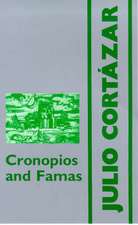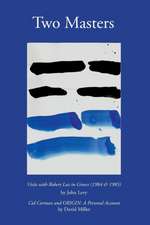Athanasius Kircher: The Last Man Who Knew Everything
Editat de Paula Findlenen Limba Engleză Paperback – 28 apr 2004
| Toate formatele și edițiile | Preț | Express |
|---|---|---|
| Paperback (1) | 385.44 lei 6-8 săpt. | |
| Taylor & Francis – 28 apr 2004 | 385.44 lei 6-8 săpt. | |
| Hardback (1) | 1252.16 lei 6-8 săpt. | |
| Taylor & Francis – 28 apr 2004 | 1252.16 lei 6-8 săpt. |
Preț: 385.44 lei
Nou
73.80€ • 75.70$ • 62.13£
Carte tipărită la comandă
Livrare economică 26 februarie-12 martie
Specificații
ISBN-10: 0415940168
Pagini: 480
Ilustrații: 50 b/w illustrations; size: 234x156
Dimensiuni: 152 x 229 x 26 mm
Greutate: 0.89 kg
Ediția:New.
Editura: Taylor & Francis
Colecția Routledge
Locul publicării:Oxford, United Kingdom
Notă biografică
Paula Findlen is Ubaldo Pierotti Professor of Italian History and Director of the Science, Technology and Society Program at Stanford University. She is the author of Possessing Nature and coeditor of Merchants and Marvels: Commerce, Science and Art in Early Modern Europe, published by Routledge.
Recenzii
Cuprins
Introduction: Athanasius Kircher and His World Section I: The Art of Being Kircher Chapter One: Eugenio Lo Sardo, "Kircher's Rome: A Way to Understand the Celeberrimus Museum Kircherianum" Chapter Two: Martha Baldwin, "Reveries in Time of Plague: Kircher and the Plague Epidemic of 1656" Chapter Three: Harald Siebert, "Kircher and His Critics: Censorial Practice and Pragmatic Disregard in the Society of Jesus" Chapter Four: Angela Mayer-Deutsch, "'Quasi-Optical Palingenesis': The Circulation of Portraits and the Image of Kircher" Section II: The Sciences of Erudition Chapter Five: Peter Miller, "Kircher, Peiresc, and the Foundation of Coptic Studies: Or, The Quest for Barachias Nephi" Chapter Six: Daniel Stolzenberg, "Four Trees, Some Amulets, and the Seventy-Two Names of God: Kircher Reveals the Kabbalah" Chapter Seven: Anthony Grafton, "Kircher's Chronology" Section III: The Mysteries of Man and the Cosmos Chapter Eight: Ingrid Rowland, "Athanasius Kircher, Giordano Bruno, and the Panspermia of the Infinite Universe" Chapter Nine: Stephen Jay Gould, "Father Athanasius on the Isthmus of a Middle State: Understanding Kircher's Paleontology, a Radical Reassessment for the Most Important Scholar of a Fascinating Time" Chapter Ten: Barbara Stafford, "Leibniz's Cosmology: Reflections in a Kircherian Mirror" Section IV: Communicating Knowledge Chapter Eleven: Haun Saussy, "Magnetic Language: Athanasius Kircher and Communication" Chapter Twelve: Nick Wilding, "Publishing the Polygraphy: Manuscript, Instrument, and Print in the Work of Athanasius Kircher" Chapter Thirteen: Noel Malcolm, "Private and Public Knowledge: Kircher, Esotericism and the Republic of Letters" Chapter Fourteen: Michael John Gorman, "The Angel and the Compass: Athanasius Kircher's Geographical Project" Section V: The Global Shape of Knowledge Chapter Fifteen: Carlos Ziller Camenietzki, "Baroque Science between the Old World and the New: Father Kircher and His Fellow Jesuit, Valentin Stansel (1621-1705)" Chapter Sixteen: Paula Findlen, "A Jesuit's Books in the New World: Athanasius Kircher and His American Readers" Chapter Seventeen: Michelle Molina, "True Lies: Kircher's China Illustrata and the Life Story of a Mexican Mystic" Chapter Eighteen: Florence Hsia "Athanasius Kircher's China Illustrata (1667): An apologia pro sua vita" Epilogue: The Afterlife of a Polymath Antonella Romano, "Kircher in Context"
Descriere
Athanasius Kircher (1602-1680) -- German Jesuit, occultist, polymath - was one of most curious figures in the history of science. He dabbled in all the mysteries of his time: the heavenly bodies, sound amplification, museology, botany, Asian languages, the pyramids of Egypt -- almost anything incompletely understood. Kircher coined the term electromagnetism, printed Sanskrit for the first time in a Western book, and built a famous museum collection. His wild, beautifully illustrated books are sometimes visionary, frequently wrong, and yet compelling documents in the history of ideas. They are being rediscovered in our own time. This volume contains new essays on Kircher and his world by leading historians and historians of science, including Stephen Jay Gould, Ingrid Rowland, Anthony Grafton, Daniel Stoltzenberg, Paula Findlen, and Barbara Stafford.-






















